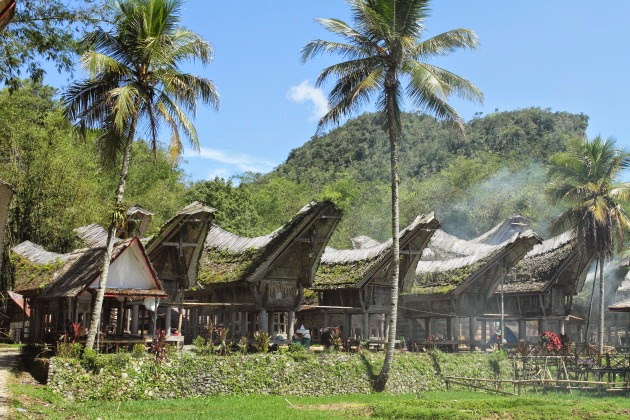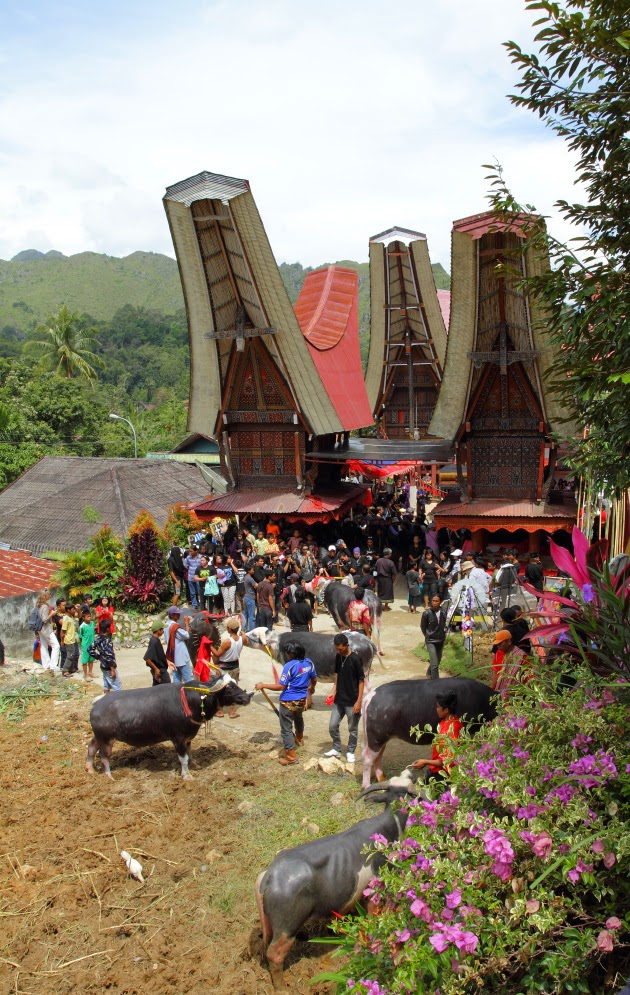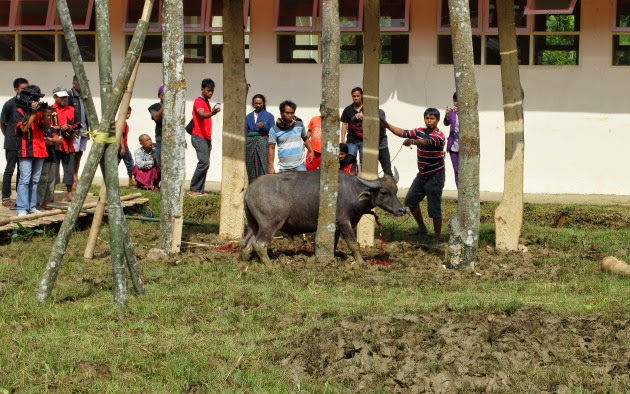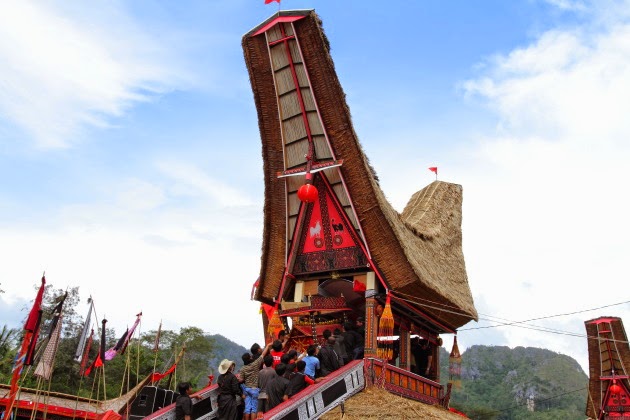Tana Toraja: We Celebrate Death!
This has been one of my favorite travel stories and it has produced jaw-dropping reactions at many of my dinner table conversations. The reaction it produces is the same when I first encountered this unique culture, which is of absolute disbelief.

Whether you are Hindu, Christian, Muslim, Buddhist or any other religion, we have all been taught to celebrate life. We welcome the birth of a new child. We celebrate the joining of a man and a woman in holy matrimony.

In simple terms, we celebrate life. But, have you ever heard of anyone celebrating death? Sounds confusing right?

This is because all of us have been taught to mourn death. But, the people of Tana Toraja, they live by a different set of rules in this department.

Thought to be sea-farers from the Philippines or one of the many islands in that belt, the Torajans settled in the lush green and fertile mountains and valleys of South-Central Sulawesi, one of the islands in Eastern Indonesia many hundreds of years ago.

Originally, they used to follow Animism, but over the course of many centuries, they embraced Christianity, but still kept their Animist beliefs close.

Everything about them is very unique and that is what makes them very interesting if you are a culture buff. All the houses in Tana Toraja are shaped like inverted boats. Some folks tales say that, the Torajans used their boats to set up their first houses. Other folk tales say that the chief of the group dreamt of such houses in his dream and thus orchestrated the first village in that fashion.

Whatever the folk tale or the reason, seeing these beautifully different houses in every corner of Tana Toraja is a sense of ‘high’ for the eyes and for the mind. But, the houses are just the start. The thing that is the most interesting in Tana Toraja are the funerals.

Many villages are invited. Everyone works in the funeral. Families and friends are there in full attendance. Food is provided in plenty. There is lots of drama and action. Animals are sacrificed in plenty. Funeral Celebrations can last from some days to some weeks. Sounds pretty different right?

I am a Hindu. We burn the dead. In Islam and Christianity, they bury the dead. The Buddhists, depending on their geography follow either burning or burial. But, irrespective of religion, we try and complete the funeral procedure as soon as possible. This is to prevent decay of the dead body and to prevent spread of any diseases.

In some cases, close family might be living in a different part of the world and hence the dead is kept in a ice box or frozen in a mortuary for preservation. But, this again is done for a maximum of 7 to 10 days and then the funeral is completed.

Here, in Tana Toraja, when someone dies in the family, there is no immediate plan to hold the funeral ceremony. Instead, the entire family works hard to put together enough money for a grand funeral that fits that social status. In the meanwhile, the dead person is injected with formaldehyde and preserved in the house.

The family members do not treat the dead person as ‘dead’. Rather, they treat them as a sick person. For example, the wife would go to her dead husband and say, ‘I made some nice pork curry and rice for lunch today. Your favorite! Why don’t you take a bite?’. Then, she leaves it near him and goes back to her other work.

The other members of the family keep having conversations with the dead person (can be his son, daughter, siblings, wife, father, mother, etc.). Everyone treats the dead like a ‘sick’ person and tries to engage him in a conversation like when he was living.

At a periodic frequency, someone keeps injecting the body with formaldehyde so that the body is in an embalmed state. The family continue their daily life with the dead person in their midst. In their minds, the dead is just sick and hence, they do their bit in taking care of the sick person. They keep doing this till they have saved enough money for a grand funeral.

In Tana Toraja, there are various social classes. Depending on their class, people are obliged to have a certain type of funeral. If you are of the highest order, you have to have a grand funeral. There will be no changes to that. Hence, many families have been known to keep the dead body in their house for weeks, months and even years, till they have enough money for a funeral that suits their class.

Well, I am sure that by now, you are all hypnotized and dumb struck. It is pretty weird, but it is true. Once the family has the money for the funeral, they send out an invite to all their extended family and friends. Every Torajan is invited. People from different villages of Tana Toraja come to contribute their bit for the funeral. Some of them help in building and decorating the funeral house. Some of them take care of the event management. Some of them bring in pigs and buffaloes. Some of them orchestrate the music. Basically, every one contributes to the funeral.
If you see the funeral up close, you will feel like everyone belongs to the family. But, the truth is that, it is the Torajan family and not just the family of the dead. The funeral house, the funeral coffin, the entire funeral event is designed in the traditional inverted boat design of the Torajans and with all their intricate art and designs.

Everyone in the family dresses in black. There are traditional dances, getups and dresses that others indulge in. Many buffaloes and pigs are sacrificed. Only male buffaloes and pigs. Sometimes as many as hundred buffaloes and pigs are sacrificed at the funeral house. This is because…The Torajans believe that animal spirits accompany and carry the spirit of the dead to the path of heaven. The more the animal spirits, the safer the passage is the belief.

And that is not the end of it. Even in the buffaloes that they slaughter, they prefer the albino ones. They believe that the albino ones are special. And just so you know, these buffaloes don’t come cheap. They quote quite a premium in Tana Toraja and are single-handedly one of the main reasons why they have to work so hard to put together the money for the funeral.

All these buffalo bulls are decked up and marched in front of the funeral procession that begins at the house after many rituals. And once they reach the funeral house, each buffalo is slaughtered (at one or two or even three per day) over the course of the multi-day or multi-week funeral celebration. The slaughtering process is painful as the buffalo dies a slow death. The same is the case with the pigs.

And once dead, all of these end up at the funeral kitchen for a grand feast. The funeral event setup is in such a way that all the family, friends and other Torajans are given a place at the funeral house. Alcohol flows. Delicious food is served. People dance, sing and make merry.

There are even bull fights that are organized for the entertainment of the people. Do note that only the rich Torajan funerals include such bull fights. The super rich funerals organize bull fights every day of the celebration as they have enough money to buy a lot of buffaloes.

I attended close to 20 such funerals during my stay at Tana Toraja and saw many slaughterings, bull fights, feasts, dances, celebrations and much more. There is no mourning in the atmosphere.

Rather, people are all happy and smiling. I took me a while to understand this emotion. But, that is because, the sick person will officially be pronounced dead at the end of the funeral celebration and that the dead will find a safe passage to heaven.

The culture is unique. The funeral is unique. The people are unique. And hence it will be apt only if the burials are also unique. The people of Tana Toraja indulge in a variety of burials. And have their own set of beliefs and rules for this too.

There are cave burials. There are rock burials. There are stone burials. Some dead are buried in a vertical cliff wall. However, they might be buried, all their coffins are intricately designed with traditional Torajan symbols and drawings.

And spirit guardians are kept at the front of the burial sites to protect the dead from negative forces.

You can get a good idea of these various burial forms as you explore the different villages of Tana Toraja.

You will also get a good idea of the beautiful landscape of Tana Toraja that is so lush green with its waterfalls, rice terraces, mountains, valleys, mountain streams and much more.

I am sure you are still dumbstruck at this story of the Torajan culture. Such cultures are one of the main reasons for my traveling far and wide. We see a world that is so very different than what we have been taught and made to believe!!

Whether you are Hindu, Christian, Muslim, Buddhist or any other religion, we have all been taught to celebrate life. We welcome the birth of a new child. We celebrate the joining of a man and a woman in holy matrimony.

In simple terms, we celebrate life. But, have you ever heard of anyone celebrating death? Sounds confusing right?

This is because all of us have been taught to mourn death. But, the people of Tana Toraja, they live by a different set of rules in this department.

Thought to be sea-farers from the Philippines or one of the many islands in that belt, the Torajans settled in the lush green and fertile mountains and valleys of South-Central Sulawesi, one of the islands in Eastern Indonesia many hundreds of years ago.

Originally, they used to follow Animism, but over the course of many centuries, they embraced Christianity, but still kept their Animist beliefs close.

Everything about them is very unique and that is what makes them very interesting if you are a culture buff. All the houses in Tana Toraja are shaped like inverted boats. Some folks tales say that, the Torajans used their boats to set up their first houses. Other folk tales say that the chief of the group dreamt of such houses in his dream and thus orchestrated the first village in that fashion.

Whatever the folk tale or the reason, seeing these beautifully different houses in every corner of Tana Toraja is a sense of ‘high’ for the eyes and for the mind. But, the houses are just the start. The thing that is the most interesting in Tana Toraja are the funerals.

Many villages are invited. Everyone works in the funeral. Families and friends are there in full attendance. Food is provided in plenty. There is lots of drama and action. Animals are sacrificed in plenty. Funeral Celebrations can last from some days to some weeks. Sounds pretty different right?

I am a Hindu. We burn the dead. In Islam and Christianity, they bury the dead. The Buddhists, depending on their geography follow either burning or burial. But, irrespective of religion, we try and complete the funeral procedure as soon as possible. This is to prevent decay of the dead body and to prevent spread of any diseases.

In some cases, close family might be living in a different part of the world and hence the dead is kept in a ice box or frozen in a mortuary for preservation. But, this again is done for a maximum of 7 to 10 days and then the funeral is completed.

Here, in Tana Toraja, when someone dies in the family, there is no immediate plan to hold the funeral ceremony. Instead, the entire family works hard to put together enough money for a grand funeral that fits that social status. In the meanwhile, the dead person is injected with formaldehyde and preserved in the house.

The family members do not treat the dead person as ‘dead’. Rather, they treat them as a sick person. For example, the wife would go to her dead husband and say, ‘I made some nice pork curry and rice for lunch today. Your favorite! Why don’t you take a bite?’. Then, she leaves it near him and goes back to her other work.

The other members of the family keep having conversations with the dead person (can be his son, daughter, siblings, wife, father, mother, etc.). Everyone treats the dead like a ‘sick’ person and tries to engage him in a conversation like when he was living.

At a periodic frequency, someone keeps injecting the body with formaldehyde so that the body is in an embalmed state. The family continue their daily life with the dead person in their midst. In their minds, the dead is just sick and hence, they do their bit in taking care of the sick person. They keep doing this till they have saved enough money for a grand funeral.

In Tana Toraja, there are various social classes. Depending on their class, people are obliged to have a certain type of funeral. If you are of the highest order, you have to have a grand funeral. There will be no changes to that. Hence, many families have been known to keep the dead body in their house for weeks, months and even years, till they have enough money for a funeral that suits their class.

Well, I am sure that by now, you are all hypnotized and dumb struck. It is pretty weird, but it is true. Once the family has the money for the funeral, they send out an invite to all their extended family and friends. Every Torajan is invited. People from different villages of Tana Toraja come to contribute their bit for the funeral. Some of them help in building and decorating the funeral house. Some of them take care of the event management. Some of them bring in pigs and buffaloes. Some of them orchestrate the music. Basically, every one contributes to the funeral.
If you see the funeral up close, you will feel like everyone belongs to the family. But, the truth is that, it is the Torajan family and not just the family of the dead. The funeral house, the funeral coffin, the entire funeral event is designed in the traditional inverted boat design of the Torajans and with all their intricate art and designs.

Everyone in the family dresses in black. There are traditional dances, getups and dresses that others indulge in. Many buffaloes and pigs are sacrificed. Only male buffaloes and pigs. Sometimes as many as hundred buffaloes and pigs are sacrificed at the funeral house. This is because…The Torajans believe that animal spirits accompany and carry the spirit of the dead to the path of heaven. The more the animal spirits, the safer the passage is the belief.

And that is not the end of it. Even in the buffaloes that they slaughter, they prefer the albino ones. They believe that the albino ones are special. And just so you know, these buffaloes don’t come cheap. They quote quite a premium in Tana Toraja and are single-handedly one of the main reasons why they have to work so hard to put together the money for the funeral.

All these buffalo bulls are decked up and marched in front of the funeral procession that begins at the house after many rituals. And once they reach the funeral house, each buffalo is slaughtered (at one or two or even three per day) over the course of the multi-day or multi-week funeral celebration. The slaughtering process is painful as the buffalo dies a slow death. The same is the case with the pigs.

And once dead, all of these end up at the funeral kitchen for a grand feast. The funeral event setup is in such a way that all the family, friends and other Torajans are given a place at the funeral house. Alcohol flows. Delicious food is served. People dance, sing and make merry.

There are even bull fights that are organized for the entertainment of the people. Do note that only the rich Torajan funerals include such bull fights. The super rich funerals organize bull fights every day of the celebration as they have enough money to buy a lot of buffaloes.

I attended close to 20 such funerals during my stay at Tana Toraja and saw many slaughterings, bull fights, feasts, dances, celebrations and much more. There is no mourning in the atmosphere.

Rather, people are all happy and smiling. I took me a while to understand this emotion. But, that is because, the sick person will officially be pronounced dead at the end of the funeral celebration and that the dead will find a safe passage to heaven.

The culture is unique. The funeral is unique. The people are unique. And hence it will be apt only if the burials are also unique. The people of Tana Toraja indulge in a variety of burials. And have their own set of beliefs and rules for this too.

There are cave burials. There are rock burials. There are stone burials. Some dead are buried in a vertical cliff wall. However, they might be buried, all their coffins are intricately designed with traditional Torajan symbols and drawings.

And spirit guardians are kept at the front of the burial sites to protect the dead from negative forces.

You can get a good idea of these various burial forms as you explore the different villages of Tana Toraja.

You will also get a good idea of the beautiful landscape of Tana Toraja that is so lush green with its waterfalls, rice terraces, mountains, valleys, mountain streams and much more.

I am sure you are still dumbstruck at this story of the Torajan culture. Such cultures are one of the main reasons for my traveling far and wide. We see a world that is so very different than what we have been taught and made to believe!!



































